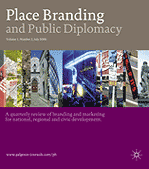Heritage management and place branding: where are the links? How do they support each other? We caught up with Susanne Fredholm of the Department of Conservation at the University of Gothenburg, Sweden, who – together with Krister Olsson – recently shared her research insights into heritage management in the academic journal Place Branding & Public Diplomacy.
Susanne, do you remember the first time you heard about place branding in connection with heritage management?
In 2014, I worked on a case study for my PhD thesis on how the surviving core of pre-1900 buildings in Cape Coast, Ghana was being utilized to empower and develop the local community as part of a sustainable pro-poor tourism strategy.
In Cape Coast I was intrigued by the fact that heritage site management was integrated into strategies aiming to create a strong place brand. But the complexity of people’s engagement with the past, people’s sense of place and the notion of heritage was simultaneously reduced almost to a technical matter.
I wanted to know more about how the abundance of heritage practices, as well as novel ideas on the potential use of historic environments that I heard of during my time in Cape Coast, could be better recognized and employed in place branding strategies.
I was moreover triggered by the challenges and untapped potential for heritage professionals in such contexts, and how heritage planning, in combination with place branding, can better benefit the local community.
Having studied image-making in the case of Fröå Mine in Åre, Sweden, has your view on place branding and heritage management changed?
No, not really. The results show that, in practice, the contribution of heritage to place branding is mainly as asset for increasing the attractiveness of the place for visitors or investors.
Basically, place branding strategies are shown to be “supply-oriented” (“these are the pre-defined historic objects or ensembles that we offer”), as opposed to “demand-oriented” (“these are the needs of the present that the past turned into heritage can help satisfy”). In my view, this is a missed opportunity and a simplification of the impact of heritage for society.
People’s livelihoods are often turned into “official heritage”, mainly focusing on tangible aspects such as buildings and facades. The “unofficial heritage”, and its intangible aspects (expressions, knowledge, and skills) represented by the use and practices carried out in the physical spaces, is often left aside.
Which would you consider the key points for place managers from your research on heritage management and place branding?
- For place branding to be successful, it is crucial to engage the local community as ambassadors for their place brand to grant credibility to any communicated message. If our connection to the historic environment in which we live is neglected or distorted, the place brand loses its plausibility as a stepping stone for further place development.
- To create mutual trust amongst stakeholders, true participatory place branding requires prevalent and dominant discourses on place, heritage and place branding to be scrutinized and re-evaluated.
- Activate and make use of civil society engagement in heritage-related issues.
- Accept the complexity of utilizing heritage in place branding activities, and engage in communicative processes where diverse interests and objectives merge to potentially create added and unexpected values.
- Make use of place-specific historic features, values and practices, but avoid simplification – every place is unique. Heritage values are neither pre-given nor universal, but discursively constructed and must be assessed in productive and contextualized ways.
To what extent do heritage management and place branding strategies overlap and complement each other?
My perspective is that they both share the theoretical aim of addressing not only the “external market”, such as tourists and businesses, but the residents and users, to promote pride in residing in an area and to create a sense of belonging and ownership.
Place branding, in this sense, is not about selling an image, but about communicating an image based on everything that goes on in a place, which requires the well-being of people.
And heritage management, in turn, is not about managing a category of material objects, but more about managing change and the values people ascribe to places and practices.
In many parts of the world today, political goals are to integrate culture, creativity, and heritage not only as factors for attractiveness and a competitive regional identity, but also for social cohesion, as well as social and economic growth.
Cross-professional collaboration between place branding and heritage management could be a fruitful way for identifying place-specific values and civil engagements that serve the interests of both the heritage sector and the image-creative sector.
Where do the two concepts differ?
It depends on how you interpret the concepts, since both disciplines and fields of practices are complex and highly debated. Research presents a vast array of reviews and definitions. If we interpret the concept of place branding as ”the selling of places” and heritage management as “the preservation of historic landscape features”, then they differ to a great extent.
My understanding of the two concepts, however, is that the basic objective of place branding is urban growth and the well-being of community, through a process of image communication to a target market in a competitive global context.
The basic objective of heritage management is the well-being of community and urban growth, through a process of sustainable management of the values people associate with a place, by striking a balance between safeguarding and developing the educational, historic, economic and cultural values.
How much the two concepts differ in practice depends on the extent to which those objectives are realized, and the chosen methodological processes.
Which trends do you observe that are likely to affect both heritage management and place branding?
Cross-professional collaboration can increasingly be observed as a trend. Place brand managers and heritage professionals are, for example, aware of the necessity of participatory processes, but resources in terms of time and funding are missing in order to implement new methodological approaches.
New collaborative formations can help re-evaluate priorities and streamline the complexities of both fields of practice.
If given the opportunity to investigate the topic further, which questions would you tackle next?
Many heritage professionals are sceptical towards place branding activities, and vice versa. They see it as a “competing interest”, and hence rarely engage themselves in projects that could benefit potential mutual interests. I want to deepen the understanding of these presumptions, examine the potentially shared interests and the new possibilities that heritage can offer for community development, which place brand managers can make use of in their practice.
Thank you, Susanne.
Read the full article here.
About Place Branding and Public Diplomacy
 Place Branding and Public Diplomacy is the first and only journal to concentrate on the practice of applying brand strategy and other marketing techniques and disciplines to the economic, social, political and cultural development of cities, regions and countries.
Place Branding and Public Diplomacy is the first and only journal to concentrate on the practice of applying brand strategy and other marketing techniques and disciplines to the economic, social, political and cultural development of cities, regions and countries.
The Place Brand Observer has teamed up with the journal’s publishers, Springer and Palgrave Macmillan, to share with you key research insights and findings.
Learn more about the journal or read the interviews with the journal editors, Robert Govers and Nick Cull.
Enjoyed this research update on how heritage management and place branding can benefit from each other? Spread the word!


